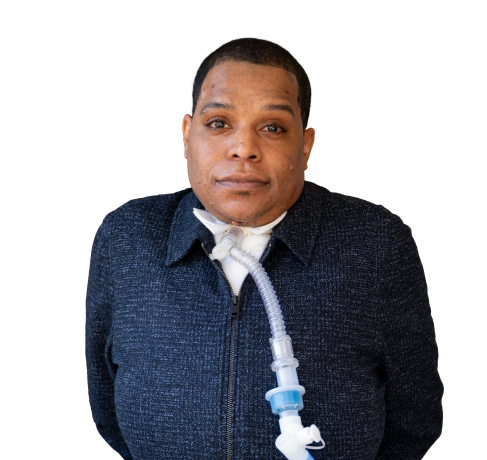This site is intended for US healthcare professionals

NF1-PN can impact every aspect of patients’ lives

I don’t wear short shorts because of the PN on my thigh. I only wear longer shorts or pants.
– Lindsey, living with NF1-PN
Neurofibromatosis type 1 (NF1) is not rare in rare disease
- NF1 is more common than cystic fibrosis (estimated at 1 in 3000 to 6000 people worldwide) and muscular dystrophy (estimated at 1 in 3500 to 5000 people worldwide)1-3
- NF1 is the most prevalent of the known neurofibromatosis (NF) syndromes, a group of genetic disorders that are associated with the development of tumors on nerve tissues4
- Other neurofibromatosis syndromes include NF2-related schwannomatosis and schwannomatosis4,5
NF1-PN can be a complex disease to manage
- Plexiform neurofibromas (PNs) can grow anywhere on the body outside of the CNS; the most common location is the head and neck area, followed by the extremities and trunk6,7,*,†
- The growth rate of PNs is unpredictable, and there may be periods of rapid growth followed by periods of relative inactivity8-11
- Pediatric patients with NF1 and symptomatic PNs have a higher mortality rate compared to those without PNs or with asymptomatic PNs6,*
- Patients with NF1 have an 8% to 16% lifetime risk of transformation to malignant peripheral nerve sheath tumors (MPNSTs)12,13

CNS=central nervous system.
NF1 patients and caregivers may be coping with a substantial QoL burden7,14-24
Physical morbidities
- Pain
- Impaired mobility
- Disfigurement
- Visual impairment
- Airway obstruction
- Spinal cord compression
- Tumors putting pressure on organs
Psychological impact
- Depression
- Anxiety
- Isolation
- Low self-esteem
- Stigma
- Embarrassment
- Fear of cancer
- Impaired sexual health
Cognitive deficits
- Inability to focus
- Impaired memory
- Impaired visual and motor function
- Learning disabilities
Logistical setbacks
- Trouble finding an HCP who specializes in NF
- Financial barriers/lack of insurance
- Travel barriers
- Difficulty coordinating appointments
In a survey about NF1-PN burden25,‡:
PAIN
In a study of patients with NF1-PN7,†:
In a separate study of patients with
NF116,§:
ANXIETY
(44/82)
DEPRESSION
(63/82)
“When I was younger, I wondered what people thought when they saw the PN on my leg because it’s visible when I’m wearing a bathing suit and it’s kind of embarrassing.”
– Lindsey, living with NF1-PN
HCP=healthcare provider; QoL=quality of life.
Many patients learn to live with their symptoms

I’m up 4 or 5 times at night because the pillow doesn’t feel right. I’ve just learned to accept it.
– Krista, living with NF1-PN


– Antwan, living with NF1-PN


– Lindsey, living with NF1-PN

Unmet needs remain in NF1-PN
Based on SpringWorks Therapeutics–sponsored market research that included 4 adult NF1-PN patients and 11 NF1-PN caregivers. Both patients and caregivers were asked to identify the emotional and experiential impact of NF1-PN on patients.24
- Ejerskov C, Farholt S, Nielsen FSK, et al. Clinical characteristics and management of children and adults with neurofibromatosis type 1 and plexiform neurofibromas in Denmark: a nationwide study. Oncol Ther. 2023;11(1):97-110.
- Scotet V, L’Hostis C, Férec C. The changing epidemiology of cystic fibrosis: incidence, survival and impact of the CFTR gene discovery. Genes (Basel). 2020;11(6):589.
- Kariyawasam D, D’Silva A, Mowat D, et al. Incidence of Duchenne muscular dystrophy in the modern era; an Australian study. Eur J Hum Genet. 2022;30(12):1398-1404.
- Tamura R. Current understanding of neurofibromatosis type 1, 2, and schwannomatosis. Int J Mol Sci. 2021;22(11):5850.
- Plotkin SR, Messiaen L, Legius E, et al. Updated diagnostic criteria and nomenclature for neurofibromatosis type 2 and schwannomatosis: an international consensus recommendation. Genet Med. 2022;24(9):1967-1977.
- Prada CE, Rangwala FA, Martin LJ, et al. Pediatric plexiform neurofibromas: impact on morbidity and mortality in neurofibromatosis type 1. J Pediatr. 2012;160(3):461-467.
- Darrigo LG Jr, Ferraz VEF, Cormedi MCV, et al. Epidemiological profile and clinical characteristics of 491 Brazilian patients with neurofibromatosis type 1. Brain Behav. 2022;12(6):e2599.
- Ferner RE, Huson SM, Thomas N, et al. Guidelines for the diagnosis and management of individuals with neurofibromatosis 1. J Med Genet. 2007;44(2):81-88.
- Akshintala S, Baldwin A, Liewehr DJ, et al. Longitudinal evaluation of peripheral nerve sheath tumors in neurofibromatosis type 1: growth analysis of plexiform neurofibromas and distinct nodular lesions. Neuro Oncol. 2020;22(9):1368-1378.
- Ly KI, Merker VL, Cai W, et al. Ten-year follow-up of internal neurofibroma growth behavior in adult patients with neurofibromatosis type 1 using whole-body MRI. Neurology. 2023;100(7):e661-e670.
- Nguyen R, Dombi E, Widemann BC, et al. Growth dynamics of plexiform neurofibromas: a retrospective cohort study of 201 patients with neurofibromatosis 1. Orphanet J Rare Dis. 2012:7:75.
- Higham CS, Dombi E, Rogiers A, et al. The characteristics of 76 atypical neurofibromas as precursors to neurofibromatosis 1 associated malignant peripheral nerve sheath tumors. Neuro Oncol. 2018;20(6):818-825.
- Miettinen MM, Antonescu CR, Fletcher CDM, et al. Histopathologic evaluation of atypical neurofibromatous tumors and their transformation into malignant peripheral nerve sheath tumor in patients with neurofibromatosis 1—a consensus overview. Hum Pathol. 2017;67:1-10.
- Gross AM, Singh G, Akshintala S, et al. Association of plexiform neurofibroma volume changes and development of clinical morbidities in neurofibromatosis 1. Neuro Oncol. 2018;20(12):1643-1651.
- Miller DT, Freedenberg D, Schorry E, Ullrich NJ, Viskochil D, Korf BR; Council on Genetics; American College of Medical Genetics and Genomics. Health supervision for children with neurofibromatosis type 1. Pediatrics. 2019;143(5):e20190660.
- Houpt AC, Schwartz SE, Coover RA. Assessing psychiatric comorbidity and pharmacologic treatment patterns among patients with neurofibromatosis type 1. Cureus. 2021;13(12):e20244.
- Foji S, Mohammadi E, Sanagoo A, Jouybari L. How do people with neurofibromatosis type 1 (the forgotten victims) live? a grounded theory study. Health Expect. 2022;25(2):659-666.
- Rosnau K, Hashmi SS, Northrup H, Slopis J, Noblin S, Ashfaq M. Knowledge and self-esteem of individuals with neurofibromatosis type 1 (NF1). J Genet Couns. 2017;26(3):620-627.
- Lai J-S, Jensen SE, Patel ZS, Listernick R, Charrow J. Using a qualitative approach to conceptualize concerns of patients with neurofibromatosis type 1 associated plexiform neurofibromas (pNF) across the lifespan. Am J Med Genet A. 2017;173(1):79-87.
- Fournier H, Calcagni N, Morice-Picard F, Quintard B. Psychosocial implications of rare genetic skin diseases affecting appearance on daily life experiences, emotional state, self-perception and quality of life in adults: a systematic review. Orphanet J Rare Dis. 2023;18(1):39.
- Radtke HB, Berger A, Skelton T, Goetsch Weisman A. Neurofibromatosis type 1 (NF1): addressing the transition from pediatric to adult care. Pediatric Health Med Ther. 2023;14:19-32.
- Leidger A, Vosschulte M, Nieder TO, Mautner V-F. Sexual self-esteem and psychological burden of adults with neurofibromatosis type 1. Front Psychol. 2022:13:883019.
- Crow AJD, Janssen JM, Marshall C, et al. A systematic review and meta-analysis of intellectual, neuropsychological, and psychoeducational functioning in neurofibromatosis type 1. Am J Med Genet A. 2022;188(8):2277-2292.
- Data on file: SpringWorks Therapeutics, Inc.
- Yang X, Yoo HK, Amin S, et al. Clinical and humanistic burden among pediatric patients with neurofibromatosis type 1 and plexiform neurofibroma in the USA. Childs Nerv Syst. 2022;38(8):1513-1522.
- Stewart DR, Korf BR, Nathanson KL, Stevenson DA, Yohay K. Care of adults with neurofibromatosis type 1: a clinical practice resource of the American College of Medical Genetics and Genomics (ACMG). Genet Med. 2018;20(7):671-682.
- Fisher MJ, Blakeley JO, Weiss BD, et al. Management of neurofibromatosis type 1-associated plexiform neurofibromas. Neuro Oncol. 2022;24(11):1827-1844.
- Rietman AB, van Helden H, Both PH, et al. Worries and needs of adults and parents of adults with neurofibromatosis type 1. Am J Med Genet A. 2018;176(5):1150-1160.
- Oates EC, Payne JM, Foster SL, Clarke NF, North KN. Young Australian adults with NF1 have poor access to healthcare, high complication rates, and limited disease knowledge. Am J Med Genet A. 2013;161A(4):659-666.
- Armstrong AE, Belzberg AJ, Crawford JR, Hirbe AC, Wang ZJ. Treatment decisions and the use of MEK inhibitors for children with neurofibromatosis type 1-related plexiform neurofibromas. BMC Cancer. 2023;23(1):553.